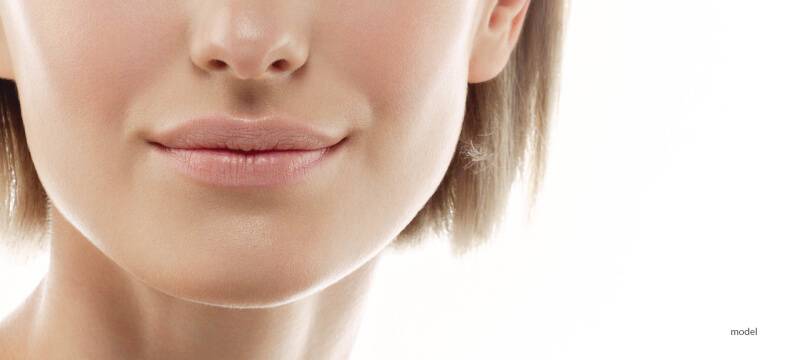Lip Fillers: How Long Do They Last?

For fuller, more symmetrical lips, lip fillers are a safe and minimally invasive aesthetic solution that can be achieved with an office visit, without the high cost or down time of surgery. If considering this method of lip augmentation, please read below for information on popular lip fillers, how long they typically last, and how to best extend your results after your filler treatment.
Lip Fillers
Lip fillers are administered in-office, where the treatment is injected strategically into the lips to add volume, define lip shape, and smooth lip lines. The effects are usually immediate after treatment, although some swelling of the lips can be expected after the procedure. The swelling subsides by 1 to 2 weeks, leaving behind the final result of the lip augmentation. Popular brands of lip fillers currently available in the United States include Juvederm, Restylane, Belotero, Radiesse, and Sculptra, with hyaluronic acid fillers of Restylane and Juvederm as the most popular.
In general, lip fillers will last 6 months to one year after treatment. The longevity will depend on the type of filler used, the amount of filler injected, the location of injection, and the patient’s personal metabolism. Most current fillers are made of hyaluronic acid, a natural biologic substance that is broken down by the body over time. Because lip fillers will degrade with time, periodic lip “touch-ups” or maintenance appointments can be performed every 2 to 6 months in order to the maintain the results of the lip filler.
Hyaluronic Acid Lip Fillers
Most lip fillers used today are made of hyaluronic acid (HA), a naturally occurring sugar molecule that attracts water. Due to its ability to bind water, HA lip fillers are extremely effective at increasing lip volume, augmenting lip protrusion, and smoothing out the overlying skin appearance. Modern lip fillers contain synthesized HA of varying molecular weights and sizes in order to create different lip filler properties and, ultimately, different lip looks. For example, more viscous fillers such as Juvederm Ultra will provide more volume projection and structure to the lip, whereas less viscous fillers such as Juvederm Volbella will integrate more into the lips to smooth the overlying skin. The elasticity and compressibility of different HA fillers distinguish their ability to move with the skin tissue during lip movement, which leads to varying degrees of natural clinical result.
While the unique properties of HA fillers make them effective for lip augmentation, these properties also contribute to their progressive loss of clinical efficacy over time. All HA fillers will ultimately be metabolized by natural enzymes in the skin called hyaluronidases, and their ability to bind water becomes increasingly less effective by the daily mechanical stress of lip movement and the exposure to free radicals. Of note, HA fillers can be dissolved and thereby reversed by an injectable biosynthesized hyaluronidase if the clinical outcome is not what was desired.
How Long Will My Lip Filler Results Last?
Lip filler longevity is based on a combination of the following factors:
- Lip filler brand and type, which includes the unique physical properties of the particular filler.
- The amount of filler used.
- The location where filler is placed.
- Your body’s natural metabolism.
With the above in mind, most patients can expect their results to last between 6 months and one year. Data from some of the most popular brands show the following average longevity:
- Restylane – a brand of hyaluronic acid-based fillers that, depending on the type chosen, can last 6 to 12 months.
- Juvederm – another brand of hyaluronic acid-based fillers that, depending on the type chosen, can last 6 to 12 months.
- Belotero – less common brand of hyaluronic acid-based fillers that can last 6 months.
- Radiesse – a calcium hydroxylapatite filler that contains no animal byproducts and stimulates new collagen formation. This filler can last 1 to 2 years, with reports of lasting 2 to 5 years, but is not recommended by the FDA for injection into the lips due to the high risk of filler migration and clumping in this area.
- Sculptra – composed of poly-L-lactic acid microparticles, this injectable induces new collagen formation that can correct volume loss. Unlike the others listed, this injectable does not cause immediate results. Multiple sessions spaced 3 to 6 weeks apart are required to see change but the results can last for up to 2 years.
- CosmoDerm/CosmoPlast – a filler of bioengineered human collagen that is not widely used, as the effects only last 2 to 4 months.
- Zyderm/Zyplast – filler of bioengineered bovine collagen with short-lived effects of 2 to 4 months and requires two skin tests beforehand to screen for allergy to the collagen.
How Can I Make My Lip Filler Results Last Longer?
To ensure you get the most out of your filler treatment, the following tips are suggested:
- Let your lips completely heal after injections before introducing too much movement.
- Avoid drinking from straws, tugging or massaging lips immediately after injections.
- Avoid sleeping on your face or touching your lips too often.
- Limit alcohol and other blood thinners for 2 days before and after treatment.
It is safe to get maintenance treatments every 6 months to continue to enjoy the results of lip fillers for longer periods. Regular injections of hyaluronic acid can even prompt your body to make more of its own collagen.
What If I Want More Permanent Lip Augmentation?
For those looking for a more permanent lip augmentation solution, the following options are available:
A surgical lip lift shortens the distance between the upper lip and nose to flip the top lip outward, creating the illusion of greater lip volume. The surgical procedure requires approximately 1 week of recovery time but leads to permanent results.
Fat injections transfer fat from a “donor” area of your own body to your “receipt” lips. Fat transfers require surgery and several days of downtime but the effects typically last for five years or more. Like hyaluronic acid fillers, the clinical results of lipotransfers seem to depend on repeated injections of small fat amounts over time, rather than single injections of larger amount of donor fat.
Lip implants are made from liquid silicone that is injected in the lip to create fullness. The surgical procedure is done in office under local anesthesia, and requires just 1 to 3 days of downtime. Results are considered semi-permanent and can last for 5 or more years. Similar to lipotransfers, silicone implants are best administered in intervals over time, with the less volume of silicone administered and more time interval between treatments as the endpoint of treatment approaches.
Despite the availability of many lip augmentation methods, hyaluronic acid lip fillers remain the most popular method, as they are effective and dissolvable with bioengineered hyaluronidase if the final results are not desired. If you are unsure of which aesthetic solution is best for your needs, please consult with your doctor to discuss the advantages and disadvantages of each one.
